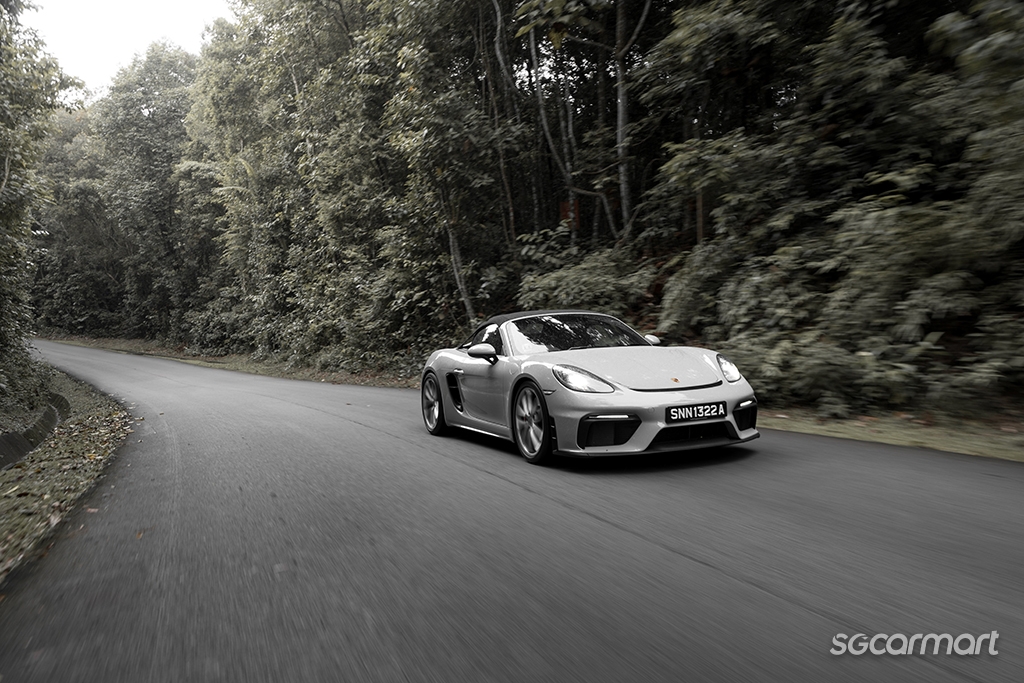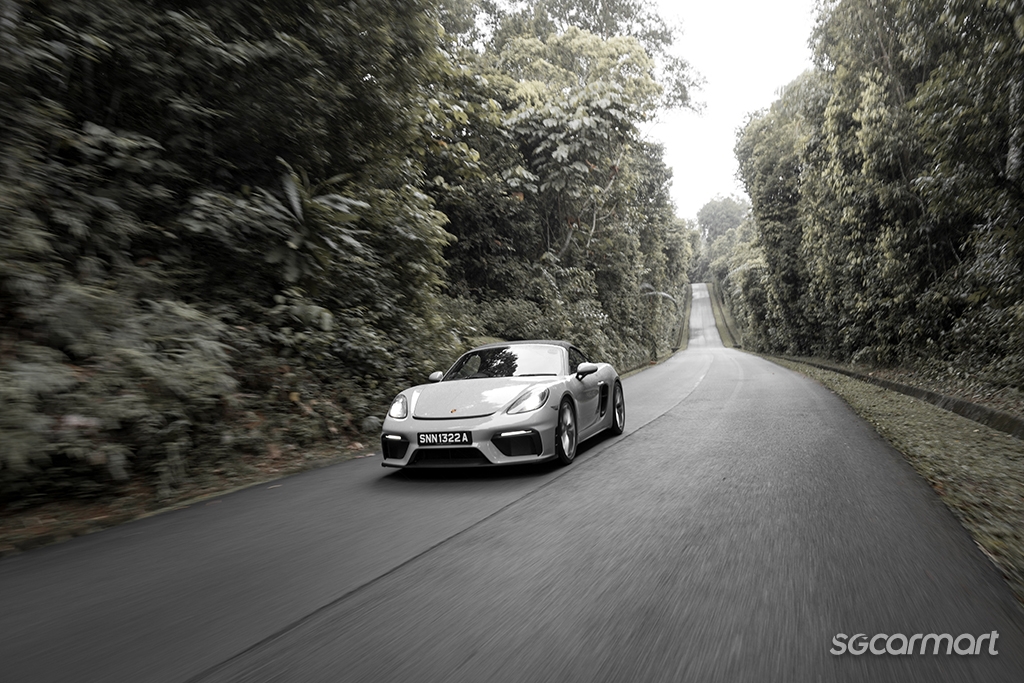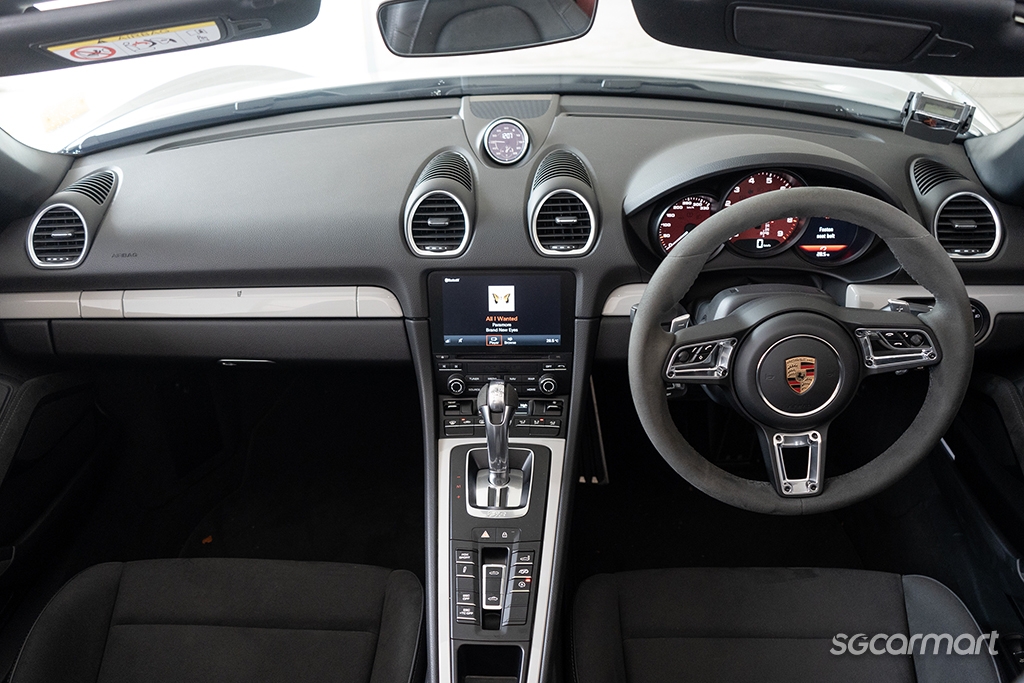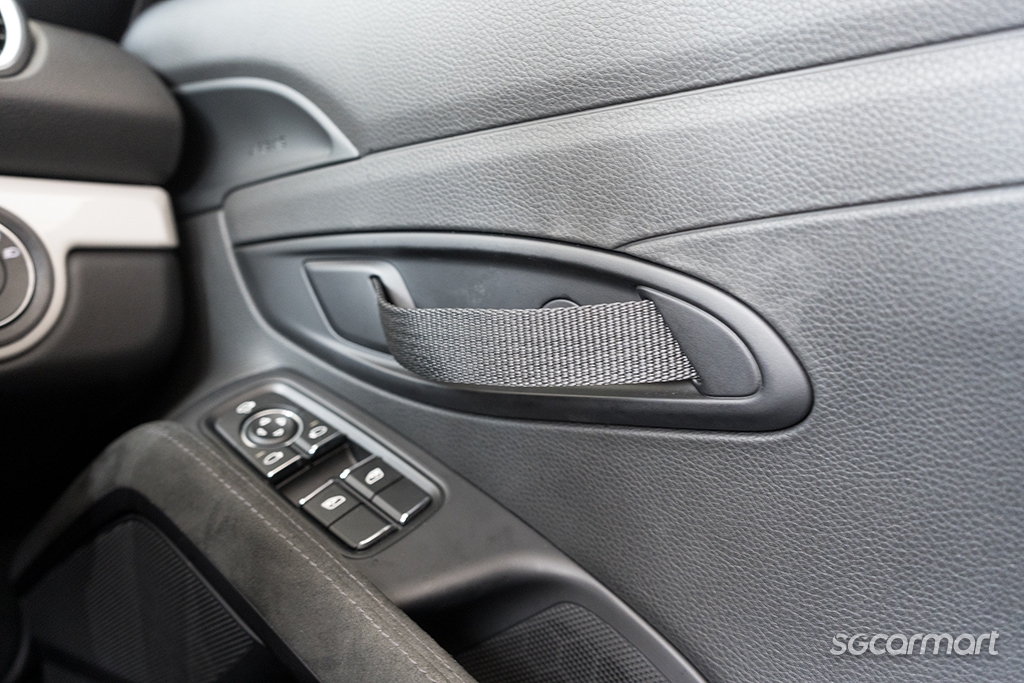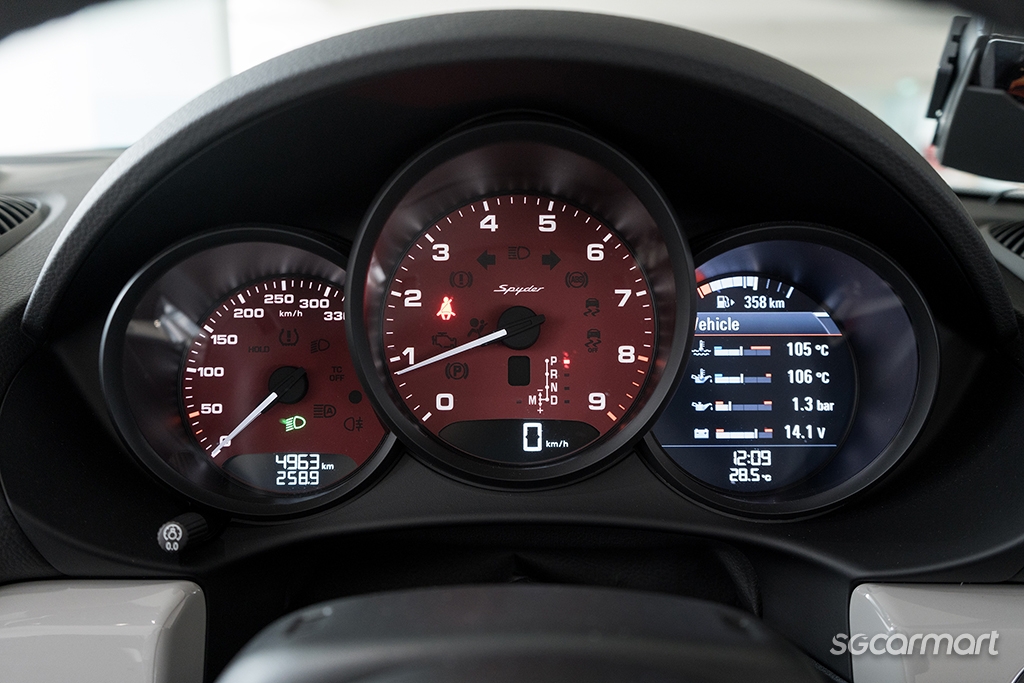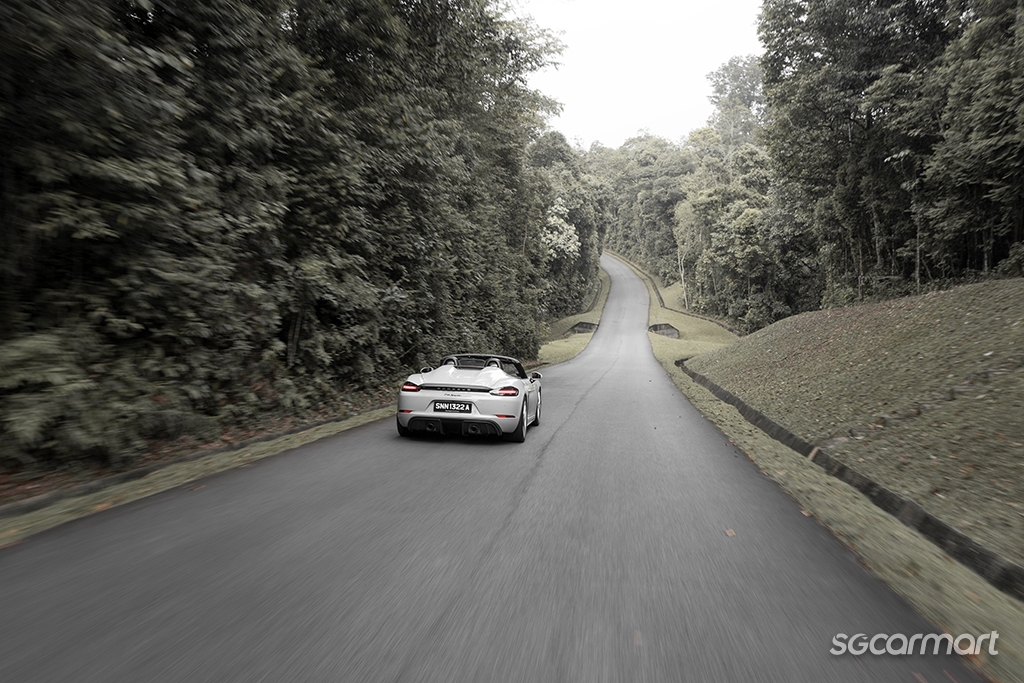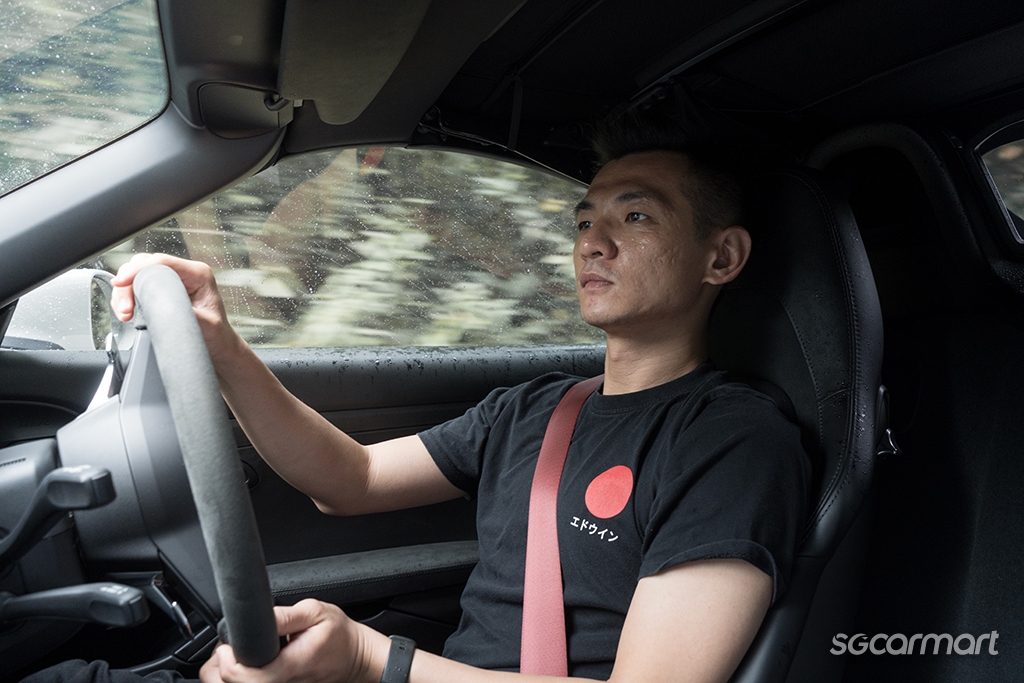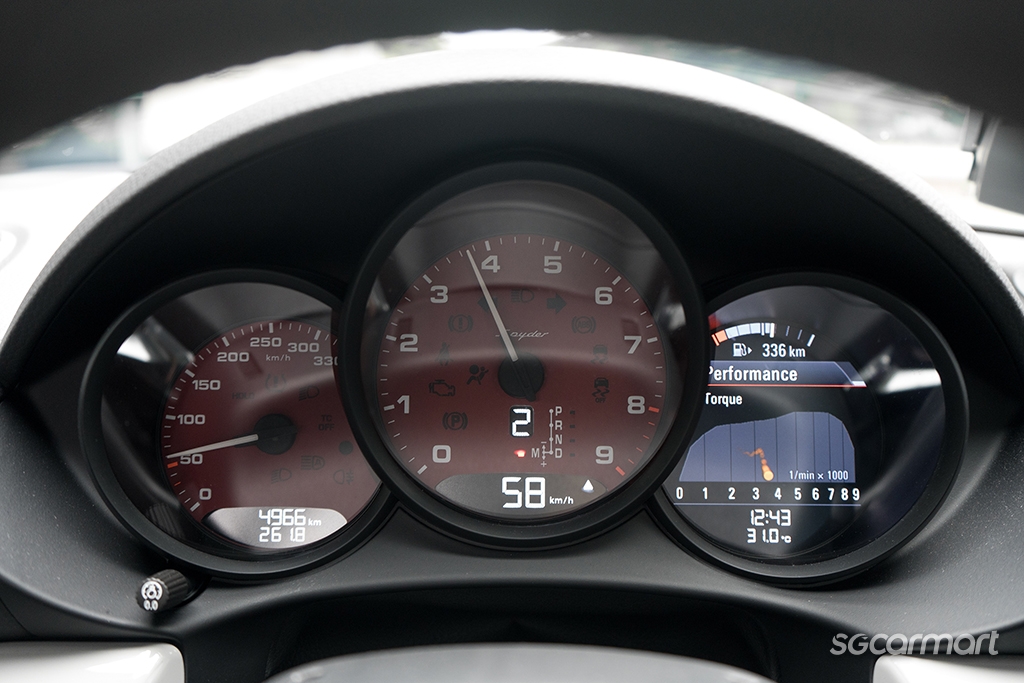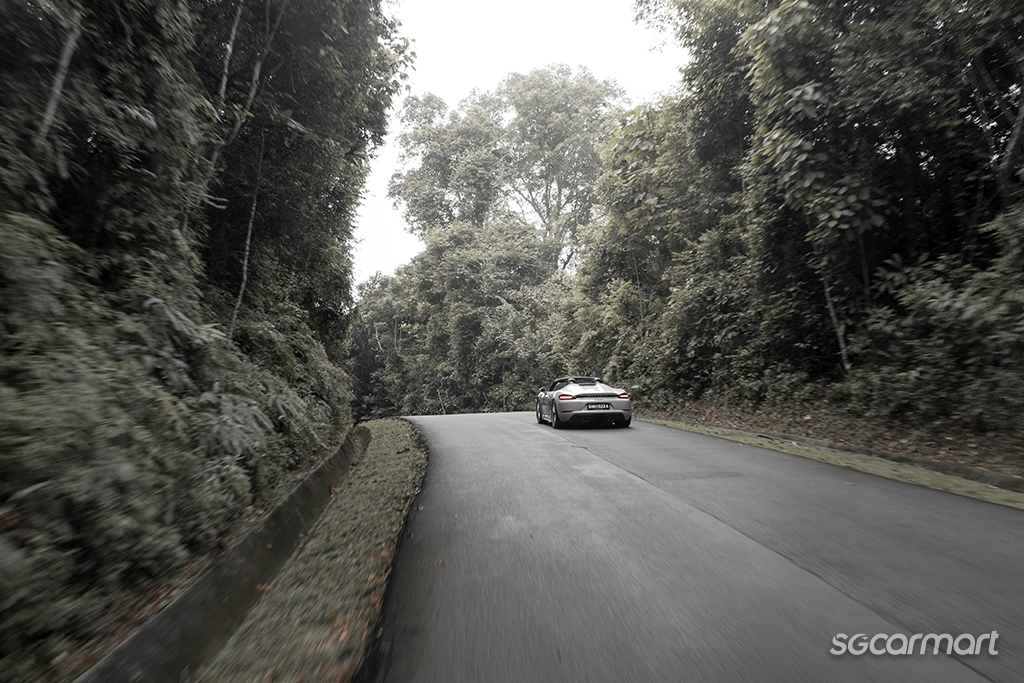Porsche 718 Spyder Review
04 Jan 2025|3,123 views
What We Like
Looks special
Simple and analogue cabin
Delightful handling
Sonic joy
Sensibly damped for daily driving
What We Dislike
Roof is fussy to operate
Struggles for practicality
Most people won't get the appeal
Porsche isn't making them anymore
Doing a photoshoot of a convertible with the grey skies threatening to burst open isn't ideal. A convertible with a roof that needs to be manually operated? Even less ideal.
At least the convertible question is the Porsche 718 Spyder.
Full disclosure: This isn't a new car. Not even close. The 718-generation was first introduced in 2016, and the 718 Spyder originally launched in 2019. So this car is kind of old.
Why then are we driving it? Well because we are fortunate enough to be able to, but also because yes, this is yet another last-of-its-kind story (I've written a few too many of those). So we're driving it because it's basically the last ever chance to do so.
What is a Porsche 718 Spyder? In essence, it's a souped-up Boxster, but it's also a little bit more than that.
While it's based on the 718 Boxster and has roughly the same shape, the 718 Spyder looks notably different. The front section is heavily revised with aerodynamic efficiency in mind - 'air curtains' on the outer edges of the front apron, the air outlet in front of the frunk lid, a redesigned front spoiler lip. The result is a much more mean and aggressive-looking car.
More notable for the 718 Spyder are the twin humps at the rear that are a classic roadster design element, as well as the rear spoiler that deploys automatically to provide rear axle downforce.
And of course, the roof. While it may look like a standard soft-top, it actually isn't. Beyond the fact that there are two little winglets that extend past the rear edge and flow neatly toward the sheet metal, what's most notable is the fact that this isn't an electrically operated roof.
Yup, manual labour is involved. And actually, quite a lot of it. Opening and closing the roof is a multi-step affair that takes between 20 to 30 seconds, and requires you to move around the car one or two times. So, really not ideal when it's threatening to rain at any moment.
The cabin is a simple, pared down affair - you don't even get door handles, with fabric tabs instead to save weight
But it's a labour that is worth it (almost) - not just because it helps save weight, but also because the 718 Spyder looks fantastic with the roof down. Shapely yet sporty, it delivers a fantastic visual blend between old-school roadster charm and new-school sports car chic.
Inside, it's a simple affair, because simplicity is entirely what this car is about. Door handles? Nope, you get some fabric instead. Electric seats? Only for adjusting the backrest. The cluster only has one digital screen, so you still get two analogue dials (this particular car has been specced with lovely bordeaux red dials). There is a BOSE Surround Sound system, but truth be told I hardly ever had music on.
Practicality is also limited. There’s not many storage spaces for the driver to put their phone/wallet/accessories. It’s strictly a two-seater, and there isn’t any space behind the seats for storage.
And there’s no escaping the reality that this is a 2016 Porsche cabin (it’s got a CD slot; when was the last time anyone used a CD), but in fact I actually think that works to its advantage. It's got a bit of analogue old school charm, and it does not distract in any way from the driving experience.
And that is exactly the point of this 718 Spyder - the driving experience.
Equipped with a naturally aspirated 4.0-litre flat-six, the sonic experience is sensational. Roof down, drop a couple gears and hit the go fast pedal, the engine sings.
414bhp and 420Nm of torque are modest numbers in today’s context, but again I think that works to the car’s advantage. You can savour its rowdy soundtrack without overly putting your driving license at risk.
Having also recently driven a GT3 (which has a similar if not exact 'hardcore' intent), the first and immediate thing that jumps out is the ride comfort. This car is firm, but forgiving. In fact, I would argue that it has better ride pliancy that some contemporary sports cars like an M3 or C63.
While this car's Cayman GT4 sibling was conceived more as a track weapon, the 718 Spyder is naturally at home on public roads. You don't need a race track to appreciate the car's balance and agility, its lightness and sharpness through windy roads. It delivers a resoundingly delightful and enjoyable experience without the need to push to the limits.
And that's where the 718 Spyder truly shines. Roof down, 6,000rpm, just soak in the music.
The 718 Spyder delivers a joyous driving experience, whether you're simply cruising along or chasing the needle to the redline
In the world of niche cars, the 718 Spyder feels particularly niche, and does come with a host of caveats.
It's not that powerful or fast; it's quite impractical; the roof is ultimately quite a faff; it's not even the best-sounding naturally aspirated flat-six Porsche makes; a 911 is actually more practical; its price tag will give most people a heart attack.
When it comes to the 718 Spyder, there are two sorts of people - people who "get it", and people who don't. For the people who don't, it's just a really expensive Boxster with a complicated roof and a noisy engine with high road tax.
But for the people who "get it", it's a really expensive Boxster with a complicated roof and a noisy engine with high road tax! The result is a car that feels particularly special. A drop-top with a naturally aspirated engine is a formula that's exceedingly rare (the only other models that come to mind are the outrageous Ferrari 12Cilindri Spider and also-outrageous Lexus LC500 Convertible), and the compromises you have to accept are part of the experience, and actually what makes it unique.
And of course, this is the last of its kind. Porsche's mid-engine sports car is slated to go electric, so this 718 Spyder also marks the last of the combustion-powered Boxsters/Caymans.
In fact, production of the 718 Spyder has already ceased, meaning that you couldn't get one brand new today. There are a few available on the used car market (such as this one, asking for $575,718), and every single one of these cars that exist today are going to be the very last of their kind.
The 718 Spyder isn't a car for most people. It isn't even a car for most enthusiasts, I reckon. It's almost painfully niche - this car isn't going to win over people's hearts, nor is it going to bring in new people into the fold. Rather, its a car made specifically for people who already have the passion and love for such cars, made for people who appreciate the particular uniqueness of this model.
As such, it's easy to be wistful about this car. And I am. It's almost impossible not to be. The 718 Spyder is a celebration of a moment already gone past. What a way to go out.
What We Like
Looks special
Simple and analogue cabin
Delightful handling
Sonic joy
Sensibly damped for daily driving
What We Dislike
Roof is fussy to operate
Struggles for practicality
Most people won't get the appeal
Porsche isn't making them anymore
Doing a photoshoot of a convertible with the grey skies threatening to burst open isn't ideal. A convertible with a roof that needs to be manually operated? Even less ideal.
At least the convertible question is the Porsche 718 Spyder.
Full disclosure: This isn't a new car. Not even close. The 718-generation was first introduced in 2016, and the 718 Spyder originally launched in 2019. So this car is kind of old.
Why then are we driving it? Well because we are fortunate enough to be able to, but also because yes, this is yet another last-of-its-kind story (I've written a few too many of those). So we're driving it because it's basically the last ever chance to do so.
What is a Porsche 718 Spyder? In essence, it's a souped-up Boxster, but it's also a little bit more than that.
While it's based on the 718 Boxster and has roughly the same shape, the 718 Spyder looks notably different. The front section is heavily revised with aerodynamic efficiency in mind - 'air curtains' on the outer edges of the front apron, the air outlet in front of the frunk lid, a redesigned front spoiler lip. The result is a much more mean and aggressive-looking car.
More notable for the 718 Spyder are the twin humps at the rear that are a classic roadster design element, as well as the rear spoiler that deploys automatically to provide rear axle downforce.
And of course, the roof. While it may look like a standard soft-top, it actually isn't. Beyond the fact that there are two little winglets that extend past the rear edge and flow neatly toward the sheet metal, what's most notable is the fact that this isn't an electrically operated roof.
Yup, manual labour is involved. And actually, quite a lot of it. Opening and closing the roof is a multi-step affair that takes between 20 to 30 seconds, and requires you to move around the car one or two times. So, really not ideal when it's threatening to rain at any moment.
The cabin is a simple, pared down affair - you don't even get door handles, with fabric tabs instead to save weight
But it's a labour that is worth it (almost) - not just because it helps save weight, but also because the 718 Spyder looks fantastic with the roof down. Shapely yet sporty, it delivers a fantastic visual blend between old-school roadster charm and new-school sports car chic.
Inside, it's a simple affair, because simplicity is entirely what this car is about. Door handles? Nope, you get some fabric instead. Electric seats? Only for adjusting the backrest. The cluster only has one digital screen, so you still get two analogue dials (this particular car has been specced with lovely bordeaux red dials). There is a BOSE Surround Sound system, but truth be told I hardly ever had music on.
Practicality is also limited. There’s not many storage spaces for the driver to put their phone/wallet/accessories. It’s strictly a two-seater, and there isn’t any space behind the seats for storage.
And there’s no escaping the reality that this is a 2016 Porsche cabin (it’s got a CD slot; when was the last time anyone used a CD), but in fact I actually think that works to its advantage. It's got a bit of analogue old school charm, and it does not distract in any way from the driving experience.
And that is exactly the point of this 718 Spyder - the driving experience.
Equipped with a naturally aspirated 4.0-litre flat-six, the sonic experience is sensational. Roof down, drop a couple gears and hit the go fast pedal, the engine sings.
414bhp and 420Nm of torque are modest numbers in today’s context, but again I think that works to the car’s advantage. You can savour its rowdy soundtrack without overly putting your driving license at risk.
Having also recently driven a GT3 (which has a similar if not exact 'hardcore' intent), the first and immediate thing that jumps out is the ride comfort. This car is firm, but forgiving. In fact, I would argue that it has better ride pliancy that some contemporary sports cars like an M3 or C63.
While this car's Cayman GT4 sibling was conceived more as a track weapon, the 718 Spyder is naturally at home on public roads. You don't need a race track to appreciate the car's balance and agility, its lightness and sharpness through windy roads. It delivers a resoundingly delightful and enjoyable experience without the need to push to the limits.
And that's where the 718 Spyder truly shines. Roof down, 6,000rpm, just soak in the music.
The 718 Spyder delivers a joyous driving experience, whether you're simply cruising along or chasing the needle to the redline
In the world of niche cars, the 718 Spyder feels particularly niche, and does come with a host of caveats.
It's not that powerful or fast; it's quite impractical; the roof is ultimately quite a faff; it's not even the best-sounding naturally aspirated flat-six Porsche makes; a 911 is actually more practical; its price tag will give most people a heart attack.
When it comes to the 718 Spyder, there are two sorts of people - people who "get it", and people who don't. For the people who don't, it's just a really expensive Boxster with a complicated roof and a noisy engine with high road tax.
But for the people who "get it", it's a really expensive Boxster with a complicated roof and a noisy engine with high road tax! The result is a car that feels particularly special. A drop-top with a naturally aspirated engine is a formula that's exceedingly rare (the only other models that come to mind are the outrageous Ferrari 12Cilindri Spider and also-outrageous Lexus LC500 Convertible), and the compromises you have to accept are part of the experience, and actually what makes it unique.
And of course, this is the last of its kind. Porsche's mid-engine sports car is slated to go electric, so this 718 Spyder also marks the last of the combustion-powered Boxsters/Caymans.
In fact, production of the 718 Spyder has already ceased, meaning that you couldn't get one brand new today. There are a few available on the used car market (such as this one, asking for $575,718), and every single one of these cars that exist today are going to be the very last of their kind.
The 718 Spyder isn't a car for most people. It isn't even a car for most enthusiasts, I reckon. It's almost painfully niche - this car isn't going to win over people's hearts, nor is it going to bring in new people into the fold. Rather, its a car made specifically for people who already have the passion and love for such cars, made for people who appreciate the particular uniqueness of this model.
As such, it's easy to be wistful about this car. And I am. It's almost impossible not to be. The 718 Spyder is a celebration of a moment already gone past. What a way to go out.
Thank You For Your Subscription.
- Roadster Chic
- Sonic Joy
- Being Wistful

















































